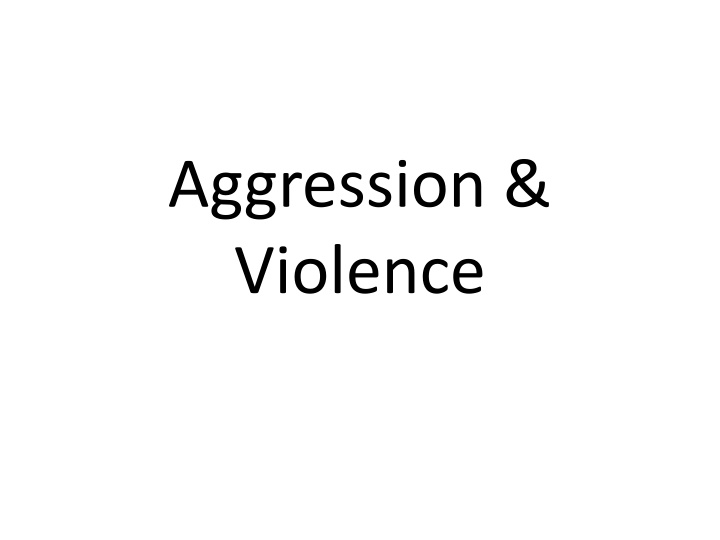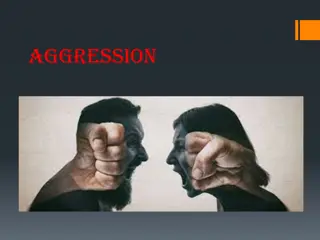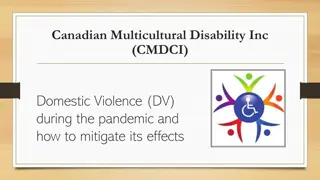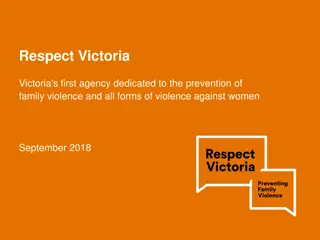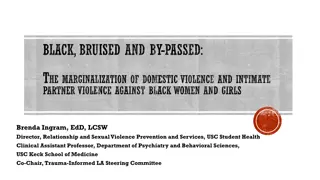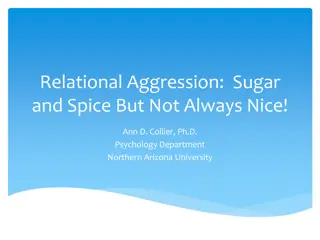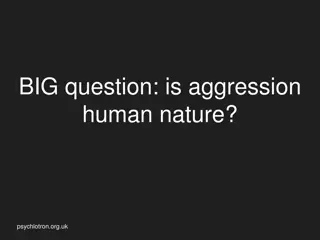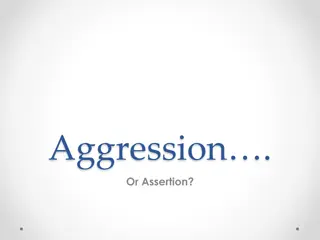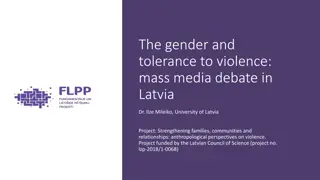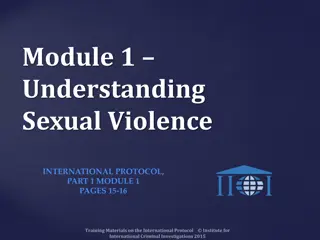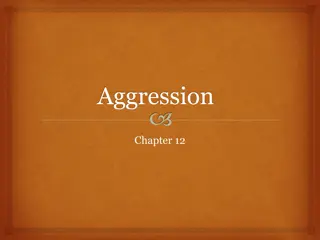Aggression and Violence: Theories and Influences
Exploring the concept of aggression, this content delves into various theories surrounding aggressive behavior, such as the Biological, Frustration, and Learned Social Behavior perspectives. It also touches on influences on aggression like aversive incidents, arousal, and media influence, while proposing methods for reducing aggression through catharsis, social learning, and cultural changes. The content further examines the different types of aggression in animals and humans, as well as the role of aggression in terrorism, wars, and bullying. Additionally, it delves into Biological perspectives on aggression, including the Instinct Theory and Evolutionary Psychology, shedding light on varying levels of aggressiveness among individuals and cultures.
Download Presentation

Please find below an Image/Link to download the presentation.
The content on the website is provided AS IS for your information and personal use only. It may not be sold, licensed, or shared on other websites without obtaining consent from the author.If you encounter any issues during the download, it is possible that the publisher has removed the file from their server.
You are allowed to download the files provided on this website for personal or commercial use, subject to the condition that they are used lawfully. All files are the property of their respective owners.
The content on the website is provided AS IS for your information and personal use only. It may not be sold, licensed, or shared on other websites without obtaining consent from the author.
E N D
Presentation Transcript
Aggression & Violence
Outline What is aggression? Some Theories of Aggression Biological Perspective Frustration Perspective Learned Social Behavior Perspective What are some influences on aggression? Aversive Incidents Arousal Media Influence How can aggresion be reduced? Catharsis Social Learning Approach Culture Change and World Violence 2
What is aggression? Physical or verbal behavior intended to hurt someone. Excludes unintentional harm (car accidents), events includes pain as an unavoidable pain (dental treatments) or assisted suicide (euthanasia). Includes kicks, slap, threats, insults, even gossip, destroying property, lying and any other behaviors whose goal is to hurt. 3
What is aggression? Animals display two types of aggression: Social aggression: displays of rage. Silent aggression: stalking the prey. Human also show two types of aggression: Hostile aggression: springs from anger and aim to injure. Instrumental aggression: an aggressive behavior intended to achieve a goal. Aggression is used as a tool. 4
What is aggression? Most of the terrorist attacks are instrumental aggression. Terrorists seek personal significance (being a hero or martyr- ehit). Wars are also instrumental aggression. Bullying adolescents who bully others often seek to demonstrate their dominance. But, murders are hostile aggression. 5
Some Theories of Aggression Biological Perspective Are humans benign or brute? Rousseau: blames society for social evils. Hobbes: credits society for restraining the brute. Freud: aggressive drive is inborn and inevitable. Instinct Theory and Evolutionary Psychology Aggressive energy is instinctive. It redirects toward others the energy of a primitive death urge (Freud). 6
Some Theories of Aggression Biological Perspective Instinct Theory and Evolutionary Psychology But this theory fails to explain the variations in aggressiveness among different people and cultures. The famous view of male aggression comes from this point of view. Competing with males and being successful bring social status. Yet, this theory may help to understand why aggression is highest during adolescence. Competition for mates and status are relatively high that time. 7
Some Theories of Aggression Biological Perspective Neural Influences Aggression is a very complex behavior that no one can spot a particular brain area responsible. But in some studies, activation of some brain areas increases hostility. Does this mean that violent people s brain are in some way abnormal? Prefrontal cortex is less active and smaller. 8
Some Theories of Aggression Biological Perspective Genetic Influences There is no one type of aggressiveness. It varies among individuals. According to some researchers, neither bad genes nor a bad environment alone predispose later aggressiveness and antisocial behavior; rather, genes predispose some people to be more sensitive and responsive to maltreatment. So, nature and nurture interact. 9
Some Theories of Aggression Biological Perspective Biochemical Influences Alcohol: it unleashes aggression and reduces self- awareness. It also makes people tend to interpret unclear acts as provocations (ne itiyosun kavgas ). Testosterone: some amount of research showed that testosterone and human aggressiveness does correlate. Low Serotonin: low level of the neurotransmitter serotonin, for which the impulse-controlling frontal lobes have many receptors. 10
Some Theories of Aggression Biological Perspective Biochemical Influences Biology and behavior interaction: It is important to remember that the traffic between testosterone, serotonin, and behavior flows both ways. Testosterone, for example, may facilitate dominance and aggressiveness, but dominating or defeating behavior also boosts testosterone levels (winning teams commit more postgame assaults). 11
Some Theories of Aggression Frustration Perspective Frustration: The blocking of goal-directed behavior (hayal k r kl ). Frustration-aggression theory: The theory that frustration triggers readiness to aggress. Frustration grows when our motivation to achieve a goal is very strong, when we expected gratification, and when the blocking is complete. 12
Some Theories of Aggression Frustration Perspective We learn to inhibit direct retaliation, especially when others might disapprove or punish; instead, we displace our hostilities to safer targets. Displacement: The redirection of aggression to a target other than the source of the frustration. Generally, the new target is a safer or more socially acceptable target. For example, intense American anger over 9/11 contributed to the eagerness to attack Iraq. Note that frustration-aggression theory is designed to explain hostile aggression, not instrumental aggression. 13
Some Theories of Aggression Frustration Perspective Laboratory tests of the frustration-aggression theory have produced mixed results: Sometimes frustration increased aggressiveness, sometimes not. Berkowitz revised the classic model and found that frustration produces anger, an emotional readiness to aggress. Anger arises when someone who frustrates us could have chosen to act otherwise. Cues associated with aggression amplify aggression. 14
Some Theories of Aggression Aggression cues: bats, sticks, witnesses, etc... 15
Some Theories of Aggression Frustration Perspective Relative Deprivation Frustration is not only caused by complete deprivation; more often frustration arises from the gap between expectations and attainments. When your expectations are fulfilled by your attainments, and when your desires are reachable at your income, you feel satisfied rather than frustrated. The perception that one is less well-off than others with whom one compares oneself. 16
Some Theories of Aggression Frustration Perspective Relative Deprivation Palestinian suicide bombers have not been the most deprived of Palestinians. Like Northern Ireland s IRA, Italy s Red Brigades, and Germany s Bader-Meinhof gang, they are mostly middle class. In cultures where television is a universal appliance, it helps turn absolute deprivation (lacking what others have) into relative deprivation (feeling deprived). Social media? 17
Some Theories of Aggression Learned Social Behavior Perspective Rewards of Aggression We often witness that aggression pays. A child whose aggressive acts successfully intimidate other children will likely become increasingly aggressive. Aggressive hockey score more goals than nonaggressive players. Kill one, frighten ten thousand 18
Some Theories of Aggression Learned Social Behavior Perspective Observational Learning The theory that we learn social behavior by observing and imitating and by being rewarded and punished. https://www.youtube.com/watch?v=En7zdMkb41 Y Family: physically aggressive children tend to have had physically punitive parents who disciplined them by modeling aggression with screaming, slapping and beating. 19
Some Theories of Aggression Learned Social Behavior Perspective Observational Learning Culture: In communities where macho images are admired, aggression is readily transmitted to new generations. The broader culture also matters. Show social psychologists a man from a nondemocratic culture that has great economic inequality, that prepares men to be warriors, and that has engaged in war, and they will show you someone who is predisposed to aggressive behavior. 20
Some Theories of Aggression Aggression is most likely when we are aroused and it seems safe and rewarding to aggress. 21
What are some influences on aggression? Aversive Incidents Pain: both physiological and psychological pain, intense heat or headache. Today s ethical guidelines restrict researchers use of painful stimuli. Heat: 22
What are some influences on aggression? Aversive Incidents Attacks: Being attacked or insulted by another is especially conducive to aggression. Intentional attacks breed retaliatory attacks. 23
What are some influences on aggression? Arousal A given state of bodily arousal feeds one emotion or another, depending on how the person interprets and labels the arousal. Arousal feeds emotions. Sexual arousal and other forms of arousal, such as anger, can therefore amplify one another. Spill-over effect. The arousal, combined with hostile thoughts and feelings, may form a recipe for aggressive behavior. 24
What are some influences on aggression? 25
What are some influences on aggression? Arousal Aggression cues Children who had played with toy guns became more willing to knock down another child s blocks. This is especially so when a weapon is perceived as an instrument of violence rather than a recreational item. For example, for hunters, seeing a hunting rifle does not prime aggressive thoughts, though it does for nonhunters. 26
What are some influences on aggression? Remoteness from the victim facilitates cruelty. A knife can kill someone, but a knife attack requires a great deal more personal contact than pulling a trigger from a distance. 27
What are some influences on aggression? Media Influence Pornography and Sexual Violence A typical sexually violent episode finds a man forcing himself upon a woman. She at first resists and tries to fight off her attacker. Gradually she becomes sexually aroused, and her resistance melts. By the end she is in ecstasy, pleading for more. Depiction of sexual violence is common in popular adult videos. 28
What are some influences on aggression? Media Influence Pornography and Sexual Violence Viewing such fictional scenes of a man overpowering and arousing a woman can distort one s perceptions of how women respond to sexual coercion. increase men s aggression against women. Rape myth is that some women would welcome sexual assault and that no doesn t really mean no 29
What are some influences on aggression? Media Influence Pornography and Sexual Violence Exposure to pornography increases acceptance of the rape myth. Note that the sexual message (that many women enjoy being taken ) was subtle and unlikely to elicit counterarguing. That is why even women often believe that some other woman might enjoy being sexually overpowered. 30
What are some influences on aggression? Media Influence Aggression against Women Pornography contributes to men s actual aggression toward women. The reverse is also true. Rapists, serial killers and child molesters report using pornograhpy at unusually high rates. 31
What are some influences on aggression? Experimental studies showed us that the reverse version might not be true. Because: 32
What are some influences on aggression? 33
What are some influences on aggression? 34
What are some influences on aggression? Media Influence Television and the Internet In 73 percent of violent scenes, the aggressors went unpunished. In 58 percent, the victim was not shown to experience pain. In children s programs, only 5 percent of violence was shown to have any long-term consequences. Two-thirds depicted violence as funny. To adults, violence seems less violent when humorous. 35
What are some influences on aggression? Media Influence Television and the Internet The more violent the content of the child s TV viewing, the more aggressive the child. Maybe aggressive children prefer aggressive programs. Or maybe some underlying third factor, such as lower intelligence, predisposes some children to prefer both aggressive programs and aggressive behavior. Turkish series? 36
What are some influences on aggression? Media Influence Television and the Internet Why does TV viewing affect behavior? Media portrayals also evoke imitation (like Bandura s experiment). Arousal tends to spill over: One type of arousal energizes other behaviors. 37
What are some influences on aggression? Media Influence Television and the Internet Does prolonged viewing desensitize us to cruelty? After witnessing thousands of acts of cruelty, there is good reason to expect a similar emotional numbing. When we find ourselves in new situations, uncertain how to act, we rely on social scripts culturally provided mental instructions for how to act. 38
What are some influences on aggression? Media Influence Video Games Increases arousal. Heart rate and blood pressure rise. Increases aggressive thinking. Increases aggressive feelings. Increases aggressive behaviors. 39
What are some influences on aggression? 40
What are some influences on aggression? Media Influence Group Influences Through social contagion, groups magnify aggressive tendencies. Groups can amplify aggressive tendencies. 41
How can aggresion be reduced? Catharsis Is emotional release. Some psychologists, believing that catharsis is therapeutic, advise parents to encourage children s release of emotional tension through aggressive play. If viewing erotica provides an outlet for sexual impulses, places with high consumption of sex magazines should have low rape rates. After viewing erotica people should experience diminished sexual desire and men should be less likely to view and treat women as sexual objects. But studies show the opposites are true. Sexually explicit videos are an aphrodisiac; they feed sexual fantasies that fuel a variety of sexual behaviors. 42
How can aggression be reduced? Social Learning Approach Children become less aggressive when caregivers ignore their aggressive behavior and reinforce their nonaggressive behavior . Punishing the aggressor is less consistently effective. Threatened punishment deters aggression only under ideal conditions: when the punishment is strong, prompt, and sure when it is combined with reward for the desired behavior when the recipient is not angry We must prevent aggression before it happens. 43
How can aggression be reduced? Culture Change and World Violence The Vikings slaughtered many people but their descendants in Sweden haven t fought a war in nearly 200 years. 44
Summary What is aggression? Some Theories of Aggression Biological Perspective Frustration Perspective Learned Social Behavior Perspective What are some influences on aggression? Aversive Incidents Arousal Media Influence How can aggresion be reduced? Catharsis Social Learning Approach Culture Change and World Violence 45
